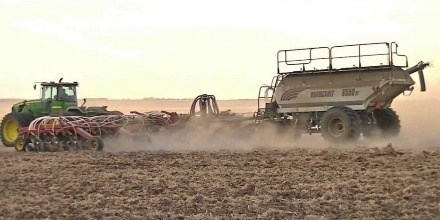Most, if not all, residents are aware of how important agriculture is to Saskatchewan, but Economic Development Regina (EDR) decided to take that thought a step further and quantify it's significance.
EDR released a report today called "Saskatchewan's Annual Megaproject: Spring Seeding" which "uses data from a range of sources to understand the impact of this investment – and examine the economic factors at play for producers as the crop year progresses."
In total, EDR notes farmers will invest about $11-billion on seeding this season; the average investment for canola is $5-billion, spring wheat $3.3-billion, and lentils $922-million.
"It's amazing how it happens every single year," said President and CEO of Economic Development Regina Chris Lane of the annual investment into seeding. "And the other part of this report is almost what it doesn't cover, and that's the spring season is only the start of the agriculture cycle, so if 11 billion dollars is the investment of putting the crop in the ground, we haven't even talked about what happens when it comes off the (ground) too, so the scale and scope has been really illuminating to understand how big of a deal this is to the local economy."
Numbers from the 2021 Census on Agriculture by Statistics Canada show "primary agriculture directly employed 3,369 people in the Greater Regina Area (GRA). That same year, operating revenue and costs for farms in the GRA amounted to $1.3-billion and $923-million respectively."
"We took a look at the kind of industries that support primary agriculture, and most of those in Saskatchewan are centered right here in Regina," Lane said. "That's everything from equipment manufacturing, equipment sales, financing and insurance; any number of industries related to processing, grain handling, all of the things needed to support a global agriculture industry are centered right here in Regina."
The cost of diesel fuel in order to put canola, spring wheat, and lentils in the ground is high, according to the report.
Estimates from EDR and the Government of Saskatchewan show the total cost of diesel fuel to seed 9,151,200 acres this year is $221,886,096; for 11,816,800 acres of canola, diesel fuel costs $303,337,256; and for 3,478,500 acres of lentils, total cost of diesel fuel is $94,244,160.
"It really does start a conversation around are there other options, are there other fuel sources that are an opportunity for us here in Saskatchewan as we support the agriculture industry," noted Lane. "Some of the work that EDR is doing also is looking at is renewable diesel or alternative forms of energy that would be applicable and adoptable on the farm."
The report also mentions factors that affect agriculture, ranging from weather, to high inflation and interest rates, energy pricing and labour shortages, as well as an outlook for commodities.
"It's probably a little bit too early to tell what the endgame on commodity prices will be but we know coming off a high in the last year that things have started to soften but we'll have to see what the year holds." Lane said of the outlook.
Lane hopes the EDR report will show people "just how massive of a megaproject spring seeding is for Saskatchewan."
"We make some comparisons in the report that help people get their head around just how big it is, and we talk a lot about the massive investment in the Jansen Potash Mine...being constructed here in Saskatchewan, and spring seeding is the equivalent of doing one-point-five Jansen Potash Mines every single year.
"We're blessed to have a diversified economy in Saskatchewan, but it's pretty clear in our data and our analysis that agriculture remains a significant part of that economy to the tune of 11 billion dollars just for this part of it alone."
The full report can be found on the Economic Development Regina website.
You can also hear the full interview with President and CEO of EDR Chris Lane below.



